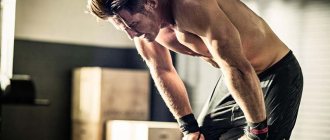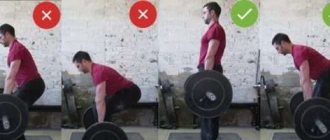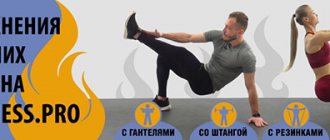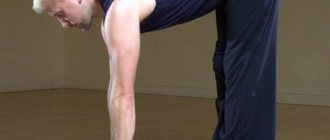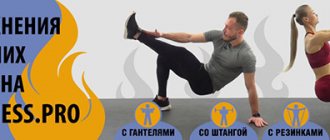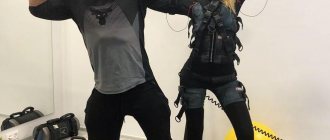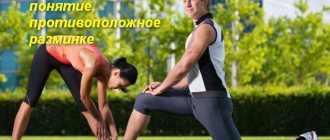Greetings, dear readers! Today I want to discuss such a common phenomenon as clogged muscles. Many gym goers experience this. Some people think that this is how it should be and that this is a sign of well-conducted training. Others are afraid and try in every possible way to avoid being overwhelmed.
Quite recently, one of my friends, who recently started training with iron, complained that the next day after training he felt sore muscles. This prompted me to write an article, because he is probably not the only one who has questions about this phenomenon.
Causes of muscle pain: where does soreness come from?
Among the main reasons that provoke pain in the leg muscles are the following:
» Inadequate physical activity. Lack of rest, excessive training intensity, working with heavy weights or repeating the exercise many times leads to depletion of the body's reserves, massive damage to muscle fibers and sore throat. » Reactivity of nerve endings. Discomfort in the legs may be caused by increased sensitivity of the nerves associated with chemical changes in cells. » Trauma. Be careful, pain does not always indicate sore throat. Acute pain that severely limits daily activities can be a sign of a dangerous injury.
Why do leg muscles hurt after training the next day: mechanics and processes
There are several reasons why legs hurt after training:
» Action of lactic acid. Intensive work requires a lot of energy, which the body receives in the process of glucose oxidation. During active movements, cells switch to anaerobic respiration, the byproduct of which is lactic acid. Excess lactate damages muscle cells, which causes a burning sensation. » Microtraumatization. Intense physical activity provokes damage to muscle fibers at the subcellular level. The injury leads to local inflammation and swelling. Excess fluid puts pressure on nerve endings, causing pain.
How to distinguish sore throat from pathological pain?
Differences between sore throat and acute pain:
| Symptom | Krepatura | Injury |
| Time of occurrence | 24-72 hours after training | Immediately during the movement |
| Localization | Diffuse pain throughout the entire muscle segment | Exclusively at the site of injury |
| Duration | 1-2 days | Without timely help it only gets worse |
| Function limitation | Slightly | Almost complete |
| Health care | Not required | Needed ASAP |
What happens to muscles during training. The physiological side of gaining muscle mass
After exercise, your body repairs old damaged muscle fibers or forms new protein compounds (myofibrils). The restored myofibrils increase in thickness and number, creating muscle hypertrophy (growth). Muscle growth is associated with the predominance of protein synthesis over its breakdown and occurs not during training, but during rest.
There are also satellite cells that act as stem cells for your muscles. When activated, they help nucleoids enter muscle cells. And this already leads to the growth of myofibrils.
The ability to activate satellite cells is a key factor that distinguishes genetic uniques from hard gainers (i.e. people who are not predisposed to gaining muscle mass).
The most interesting discovery over the past 5 years has been that in people whose muscles respond well to exercise, the level of myofibril hypertrophy reaches 58% with activation of satellite cells by 23%. As the number of activated cells decreases, hypertrophy also decreases. If a person’s muscles do not respond to the load, there is not only no myofibril hypertrophy, but also activation of satellites (0%). And so it turns out that the more you engage your satellite cells, the more you will grow. The question arises: how to activate satellite cells for muscle growth?
How to Relax and Recover Your Legs After a Workout: Reduce Muscle Pain
The most common ways to relax your legs:
» Adequate rest. Repair and formation of new cells occurs during sleep. Healthy rest promotes the elimination of lactic acid and other products of anaerobic respiration, which helps restore legs after exercise. " Warm. To reduce leg pain after exercise, it is recommended to take a warm bath, apply a heated towel to the painful area, or visit a sauna. Essential oils of lavender, orange, geranium, frankincense, bergamot, lemon balm and rose will help you relax faster and relieve psychological stress. " Nutrition. Green tea and foods rich in vitamins E, A and C speed up the binding and elimination of toxins. " Sports nutrition. The use of creatine, BSSA, glutamine and omega-3 helps to quickly restore energy in the body after and during training. " Massage. Stroking and intensive kneading help relax the muscles and reduce soreness. Be careful, massage, although it provides relief, can be quite painful in itself. Acupuncture and roller massage are considered an excellent option for getting rid of sore throat. » Increasing the frequency of training. To prevent muscle pain and discomfort, it is better to exercise less, but more often. Then the muscles will not overwork and adapt to the load faster.
Internal back muscle training
This training is for training the internal back muscles
do it as follows - if you cannot complete a certain exercise, then repeat it several times, then continue to do the next exercise. If everything works out right away, make the training a little more difficult.
- Stand up straight. Place your hands on your waist. Place your feet together. Close your eyes for 30 seconds and try to stand still. If you cannot do this, repeat the exercise again.
- Stay in the same position. The feet should be on the same line. Place your right foot forward so that your heel is near the toe of your left foot. Try standing in this position for 20 seconds. Change legs and repeat the exercise again.
- Continue standing in the same position as in the first exercise. Raise your heels a little and stand on your toes. Stay like this for about 30 seconds.
On the socks
- Stand up straight . Lean forward as much as you can. Place your hands on your waist. Repeat this exercise 8 times.
- Stand up as in the second exercise. Slowly and without leaving the place, begin to bend to the sides. Do 8 bends in each direction. Make sure that the swings are light and not very deep. Change leg and repeat this exercise.
- Place your hands on your waist and close your legs . Raise your right leg and stay in this position for 30 seconds. Do the exercise with your left leg.
- Place your feet next to each other so that your toes are in line. Raise your right leg slightly forward. Raise your arms up, doing this through the sides. Put your palms together. Perform this exercise 6 times, then do the same, but with your left leg.
- Rise up on your toes . Make sure your legs remain closed. Raise your right leg and stay in this position for 10 seconds. Do the exercise with your left leg.
- Place a rug on the floor. Stand on it. Make turns around your body, but then leave the mat, then stand on it again. Place your hands on your waist. Perform the exercise 8 times on the left side, then 8 times on the right. If you feel dizzy, then fix your gaze on some point while doing it, and make fewer turns. To make this exercise more difficult, stand on your toes and fold the mat.
- Stand on your toes, keep your feet together, put your hands on your waist . Stay in this position, try to move only your neck. Turn your head to the sides, then lift your head up, lower it down.
Rotate your head
With this set of exercises you will be able to work your internal back muscles. You can do them even without experience in sports.
The most common types of discomfort after exercise
In addition to sore throat, intense physical activity can be accompanied by other unpleasant sensations. Physical discomfort often leads to psychological stress and the desire to give up training altogether. Below are the most common problems that girls encounter while working out their legs.
Leg cramps after training: why and what to do?
Cramps are involuntary, sharp and painful contractions of a muscle segment. Legs cramp after training for the following reasons:
» Deficiency of water and electrolytes. During intense work in the gym, water and electrolytes are lost through sweat. As a result, the muscles do not have enough resources for adequate contraction and malfunction occurs. » Overtraining. Excessive effort results in inconsistent relaxation of the neuromuscular spindles and decreased tendon activity, which promotes improper relaxation. » Excess carbohydrates.
Ways to quickly recover your legs after training:
" Stretching. To relieve tension as much as possible, gently stretch the muscles.
" Massage. When your calves cramp after a workout, it is recommended to rub them with circular or pinching movements.
» Ice. If your leg muscles are very sore after exercise, you can apply an ice pack or place your foot on a cold concrete floor.
Sore calves after training: why and what to do?
The calf muscles are one of the muscle groups at risk, in which soreness, cramps and other unpleasant symptoms most often occur. Discomfort may be due to the following reasons:
» Overtraining. » Delayed pain as a result of unusual loading. » Deficiency of microelements and water. » Trauma and various diseases.
If your legs hurt after training and the next day, you can use the following techniques:
» Stop training and give your legs a rest. » Raise your legs above head level. » Take a contrast shower. » Massage your calves with a foam roller.
Stiff legs after training: why and what to do?
The extreme degree of muscle strain is called congestion. Excessive tension leads to the accumulation of blood, metabolic products and swelling of the segment. As a result, the fibers continue to contract but do not relax. Clogged legs after training are manifested by the following symptoms:
» Petrification of the muscle segment; » Heaviness; » Pain; » Inability to bend or straighten the joint; » Cramps and pain.
What to do if your leg muscles are clogged after training?
“To prevent discomfort, you need to warm up and stretch before each workout. » If muscles become clogged, warming with a heating pad, massage, sauna or bath will relax the problem areas. » Clothes with a sauna effect and special creams will help warm up muscle segments in the gym. » Consumption of tocopherol improves metabolism in myocytes and reduces heaviness in the legs. » A good prevention of cramps and congestion is to walk barefoot on uneven surfaces: pebbles, sand, earth.
Legs shake and tremble after training: why and what to do?
Tremor is an involuntary contraction of muscle fibers; trembling in the legs is associated with the following reasons:
» Inadequate load. The muscles have not yet adapted to this level of tension, which causes excessive effort in them. As a result, the fibers contract but do not relax well. " Fatigue. A lack of energy resources can lead to tremors. » Incorrect technique. When the load is distributed incorrectly, the body tries to find ways to compensate for the balance. » Lack of protein and carbohydrates. Lack of nutrients reduces the energy potential of cells.
When your legs shake after a workout, it is recommended to review your fitness plan and reduce the load. After 2-6 weeks, the body will adapt to the work and become stronger, allowing you to return to the desired level of stress. Other effective methods that will help relieve weakness in the legs include:
» Contrast water procedures; » Drinking a decoction of mint and lemon balm; » Baths with sage; " Massage; " Stretching; » Enrichment of the diet with meat and dairy products.
Legs burn and buzz after training: why and what to do?
The burning sensation in the legs after exercise is caused by fatigue and exhaustion. Sometimes discomfort can be associated with shoes that are too tight or squeezing blood vessels with laces. The legs burn from the sudden flow of blood to the legs. The following procedures will help relax muscles and get rid of burning:
» Contrast baths; » Keep your legs above head level (rested against a cabinet or wall) for 10-15 minutes; » Kneading and rubbing your feet with essential oils of rosemary or lavender; » Walking on uneven surfaces or kicking a pillow with your feet; " Dream; » Drinking enough water; » Application of cooling creams.
Training long back muscles at home
- Hyperextension . A simulator is required for the exercise. Position yourself on it so that the bolsters at the bottom are higher than your feet. The body, in this case, should cover the pillow on the simulator up to the hips. Cross your arms behind your head, straighten your body, make sure there are no bends in it. Lower your body so that there is a minimal stretch in the back area. Lower yourself as much as possible and return your body to its original position. Repeat this exercise to train the long back muscles a maximum of 20 times for no more than 5 sets.
For the back
- Bent-overs using a barbell. Stand up straight, bend your knees slightly. Take the barbell in your hands. Bend forward so that your body is parallel to the floor. For the exercise, do not take a very large barbell, since all the load can go to the back muscles of the thighs. Do the exercise 10 times. Repeat it in 4 sets. If you want to get better results, do the exercise while sitting. Take the barbell with less weight. Do 5 approaches in total, 15 times each.
Don't take too much weight
- "Deadlift". Place a barbell in front of you. Take it so that the bar is almost near your feet. Take the barbell at shoulder width, even a little more. Sit down slowly, arch your back, and lift the barbell. At the same time, tense your back muscles. Lower the bar. When you do the exercise, try to stand upright. During execution, use only the long, deep muscles of the back. To build muscle tissue, perform 6 exercises in a row. Do 4 sets.
Power
- Pull-up . Grasp the bar so that you feel comfortable. Do not touch your feet to the floor, straighten your torso. Pull yourself up until your chin touches the bar. Hold this position for a few seconds. Lower yourself and repeat the exercise again. Perform the movement 10 times. In total you need to do 5 approaches.
Many muscles are involved
- Barbell row to the chin. Straighten your body and grasp the barbell with your hands wide. Spread your elbows to the sides, lift the barbell to your chin, hold in this position for 1 second. Then lower the barbell to the floor. Do the exercise 15 times. Do 5 approaches in total.
Effectively
How to prevent leg pain after exercise?
A few tips on how to prevent sore throat:
» Warm up, cool down and stretch. To prepare your muscles for the load as much as possible, you should warm up thoroughly. Stretching will also help avoid cramps. » Consumption of water and energy reserves. During training, in order to prevent cell dehydration and maintain tissue respiration at an optimal level, it is recommended to drink enough water and consume BCCA. » Adequate load. Working with moderate weights, a small number of sets and repetitions prevents fatigue and the effect of overtraining. » Training mode. It is better to exercise less, but more often and perform the exercise technique correctly. » Load stability. It is not recommended to suddenly change the type of load and move from working one muscle group to another. Maintain the same pace and intensity of the workout, without sudden jumps. » Rest mode. Sleep and rest between exercises are essential components for recovery and production of new muscle cells. » Diet. To prevent nutritional deficiencies, as well as potassium, calcium and magnesium, which are necessary for normal muscle contraction, it is recommended to adhere to a balanced diet. A lack of carbohydrates and lipids will lead to energy deficiency. A lack of protein can lead to muscle atrophy.
Training the trapezius back muscle at home
- Exercise with a barbell. Use a medium grip; your shoulders should not be involved in the work. Pull the barbell to your chin and lift your elbows up so that they are parallel to the tops of your ears. To pump up your upper trapezius, hold the barbell at the top for a few seconds. If you are a beginner, we recommend using dumbbells to train the trapezius muscles of the back
, since with a barbell you will not be able to immediately engage the trapezius muscles, only the shoulders.
- Shrugs with dumbbells are the most effective exercises for working the trapezius muscles. There are quite a lot of techniques to perform. You can take a barbell or weights, stand up straight or sit down, use a narrow or wide grip. Place the dumbbells along your torso, do not bring them forward. Before lifting the projectile, spread your shoulder blades to the maximum. To prevent your joints from being damaged or injured, do not roll your shoulders. During the exercise, focus only on lifting the dumbbells up, then down.
Correctness is important
- Deadlift with a barbell using a narrow grip . To perform this exercise, take dumbbells or use a machine. However, the ideal option is an EZ bar . If you don’t have such a bar, use the usual option. Raise and then lower the barbell slowly, control your own movements. Tighten your muscles as you lift the barbell. Also use your shoulders during the exercise.
With a bar or dumbbells
- Swings with dumbbells. In this exercise, also use your shoulders (deltoid muscles). You can perform the exercise in a standing or sitting position, with your arms bent slightly. Spread your arms out to your sides so that they are parallel to the floor surface. Place your wrists at the very top so that they are lower than your elbows.
Breeding
- Shrugs with a barbell in front of you. This exercise is considered fundamental. It is thanks to him that the trapezius muscles will develop faster. The technique of execution resembles the technique of the first exercise. They differ only in the weight that you will use. Place a barbell in front of you. There should be a distance of 50 cm between your legs. Raise the barbell using rows. The shoulder blades must be brought together, the shoulders straightened, the arms relaxed. The bar should hang in your hands. Squeeze your shoulders, wait a couple of seconds, and slowly lower the projectile.
In front of
- Shrugs with a barbell behind your back. This exercise is more difficult than the previous version. Although it works almost identically. Stand up and place the barbell behind you. Bring your shoulder blades together and bring your arms back. Take the barbell in your palm, then lift it. Relax your arms a little, raise your shoulders, lift the barbell up. Hold in this position for a second, return to the original position.
Behind
- Shrugs while lying down . Take a lying position. Start lifting light weights at first and increase them over time. Lie on your stomach on a bench with an incline so that your palms hang freely. Hold dumbbells in your palms, make sure your back is straight. Slowly squeeze your shoulders, lift the weight with your arms, and return to the original position. When you lift the dumbbells, inhale, and as you descend, exhale.
What should you not do if you have leg pain after training?
» Continue training. When muscle pain, burning or heaviness is felt after exercise, it is better to refrain from re-working the segment. It is recommended to perform a full-body workout that evenly targets all muscle groups. » Increased load. Krepatura is often an indicator of inadequate load, which, if further increased, will lead to injury. It is recommended to give the body time to adapt to the work and increase the intensity of the workout after 1-2 weeks.
» Fasting or restrictive diets. A balanced diet, taking into account the need for macro- and micronutrients, provides the body with the necessary amount of nutrients, promotes the formation of new muscle fibers and maintains the body’s health at the proper level. » Use painkillers. Tablets and ointments are not recommended to be used to combat sore throat. Medications are first aid for injuries and damage and are used only as indicated. » Apply ice. Heat or contrasting water treatments will help relax muscles and reduce pain.
Author: ForceMan from 2-08-2018, 20:59
- 0
What is muscle tightness?
A problem such as muscle soreness appears quite often during excessive stress on the body. Stress and various diseases also contribute to this. As muscles grow, small cracks appear on their surface. During this period, muscle tissue needs to recover, so it is correct to take breaks between long workouts. When the body doesn't get enough rest, the muscles become overextended.
You can relieve pain in muscle tissue using the following methods:
- massage those muscles in which the greatest discomfort is felt;
- take a warm shower, as a cold one will only aggravate muscle congestion;
- take special vitamins;
This is interesting
- [uaf_vkcount url='https://beginogi.ru/vliyanie-bega-na-organizm-cheloveka-fiziologiya-bega-ego-posledstviya/']
The influence of running on the human body, the physiology of running, its consequences
Back muscle training for spinal hernia
- Place a soft pillow under your stomach. Place your hands on your back. Raise your head. Also lift your chest and shoulders. Freeze for a couple of seconds. Take the original position. Gradually increase the duration of the exercise to train the back muscles for a herniated disc .
- Stay on your stomach. Stretch your arms, put them behind your head. Then raise your hands one at a time. Raise opposite legs at the same time. During each lift, hold the position for a few seconds.
- Perform the exercise on your back. Raise your legs, bend them. Raise your pelvis and body a little. You should have a bridge. Freeze in this position, then relax, lower yourself to the floor.
Variety in hernia
- Roll over onto your stomach. Place your hands under your chest. Raise your slightly bent legs and lower them.
- Stand on your feet and hands in a “all fours” pose. Raise your left leg and right arm at the same time. Lock the position. Repeat the movement with the other leg and arm.
- Do not leave the previous pose. Raise your legs one at a time, freezing for a few seconds during each lift of the limb.
Back muscle training for scoliosis
On the back
- Press your back to the floor surface. Raise your arms above your head, palms turned inward. Stretch your toes. Stretch your arms and legs to your sides. Relax. Do the exercise a few more times.
- Do the “Bicycle” exercise. Raise your legs up so that they are perpendicular to the floor. Bend your knees and start moving your legs, imitating riding a bicycle. Make movements forward, then back. When you can master the exercise, add crunches. Place your hands under your head and place your elbows on the floor. When you lift your body, your elbows should only be turned out. Raise your torso, turn it, reach your knees with your elbows - right to left, left to right. Exercises to train back muscles for scoliosis need to be performed several times.
Bike
- The simplest and most effective exercise is considered to be “Scissors” . If you are a beginner, raise your legs as in the previous exercise. Spread your legs to the sides. Repeat the swings up to 6 times. Perform only 3 approaches.
Scissors
Belly
- Stretch your legs and arms to the sides, then relax. Do the exercise 6 times in total.
- The “Boat” exercise helps align the spine. Pull your arms forward, also stretch out your toes and tense them. Raise your body with your arms extended, then raise your legs. Balance your torso while remaining on your stomach. Do not hold your breath, then relax, lower your body to its original position.
boat
- Spread your elbows to the sides, clasp your palms. Place your forehead on your palms, stretch your legs so that they are parallel to each other. Make movements imitating breaststroke swimming. Relax. Repeat the exercise.
- Bring your legs together and spread them, then your arms, remaining lying on your stomach. Start like the previous exercise. Extend your arms to your sides so that they are at shoulder level. Close your legs, squeeze them together. Raise your hands above your head and bring them together. Spread your legs to the sides. When you perform the exercise, keep your body, arms and legs above the floor, only your stomach should be on the floor.
standing
- Place your legs wide apart and straighten your back. Raise your palms to your shoulders and begin to rotate your arms back and forth. Make sure your posture is straight.
- Raise your legs to the sides, stretch towards the ceiling. Stand on the tips. Sit down slowly and lower your body down. Try not to stick out your buttocks, keep your back straight. Do not strain your knees, do not hold your breath. Slowly, very smoothly rise to the top. Repeat the exercise several times.
For pain and scoliosis
Rhomboid back muscle training
- Bring your shoulder blades together and stand straight. Take dumbbells and bring your shoulder blades closer to each other. Do this exercise 15 times. You can do it in several approaches.
- You will have to do the exercise on the horizontal bar. With this workout you will work your rhomboid back muscles. You will imitate pull-ups on a horizontal bar, using the barbell's pull towards your chest. Hence, if you are a regular gym goer, don't skip this exercise.
On the horizontal bar
- Bent-over rows using dumbbells. Lunge with your left leg. Place the elbow of your left hand on your knee. Take a dumbbell in your other hand, bend and then straighten your arm with the instrument. Repeat the exercise 20 times. Do it by switching hands. The most important thing in this exercise is to perform the movements so that the load is placed on the shoulder blades.
- the exercise to train the rhomboid back muscles slowly. You should feel tension appear in your rhomboid muscles. To better engage the minimus and rhomboid muscles, do a push-up. During each push-up, hold the tense position for a few seconds. You can tighten the area of your shoulder blades more.
Push-ups
We also offer a basic exercise for the rhomboid back muscles:
- Stand or sit on the floor. Straighten your back.
- Lower your chin a little.
- You will need to pull your shoulder blades back.
- Then slowly tense your back muscles, bring your shoulder blades together (to the maximum).
- Hold in this state for about 5 seconds.
- Do it 10 times.


